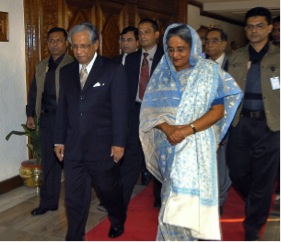by rahnuma ahmed

As I conclude my series on the consortium government, I’d like to let my readers know that what I’ve been writing (7 parts, this included) was a mere scratch of the tip of the iceberg. That, since the more I delved, the more intrigued I became, I have decided to continue my research, and will probably write about some of the themes later, in these pages, after having examined them in greater detail.
At a more general level, I have argued that terming Fakhruddin’s regime as a “military-installed caretaker government,” which, when it had been coined, had helped to unmask the character of the regime, had helped to expose its repeated objectives of “strengthening Bangladesh’s democratic order” (Fakhruddin) http://tinyurl.com/39pheg as being rhetorical moves concealing ulterior motives, but however, that, a critical look, aided by hindsight, leads me to believe that one needs to further our analysis, that forces which were then identified as being supporters of the regime, i.e., shusheel shomaj, and western diplomats, were intrinsic to the regime, formed its constitutive elements. Continue reading “CONCLUDING PART Military-installed caretaker govt, or a 'consortium' govt?”
